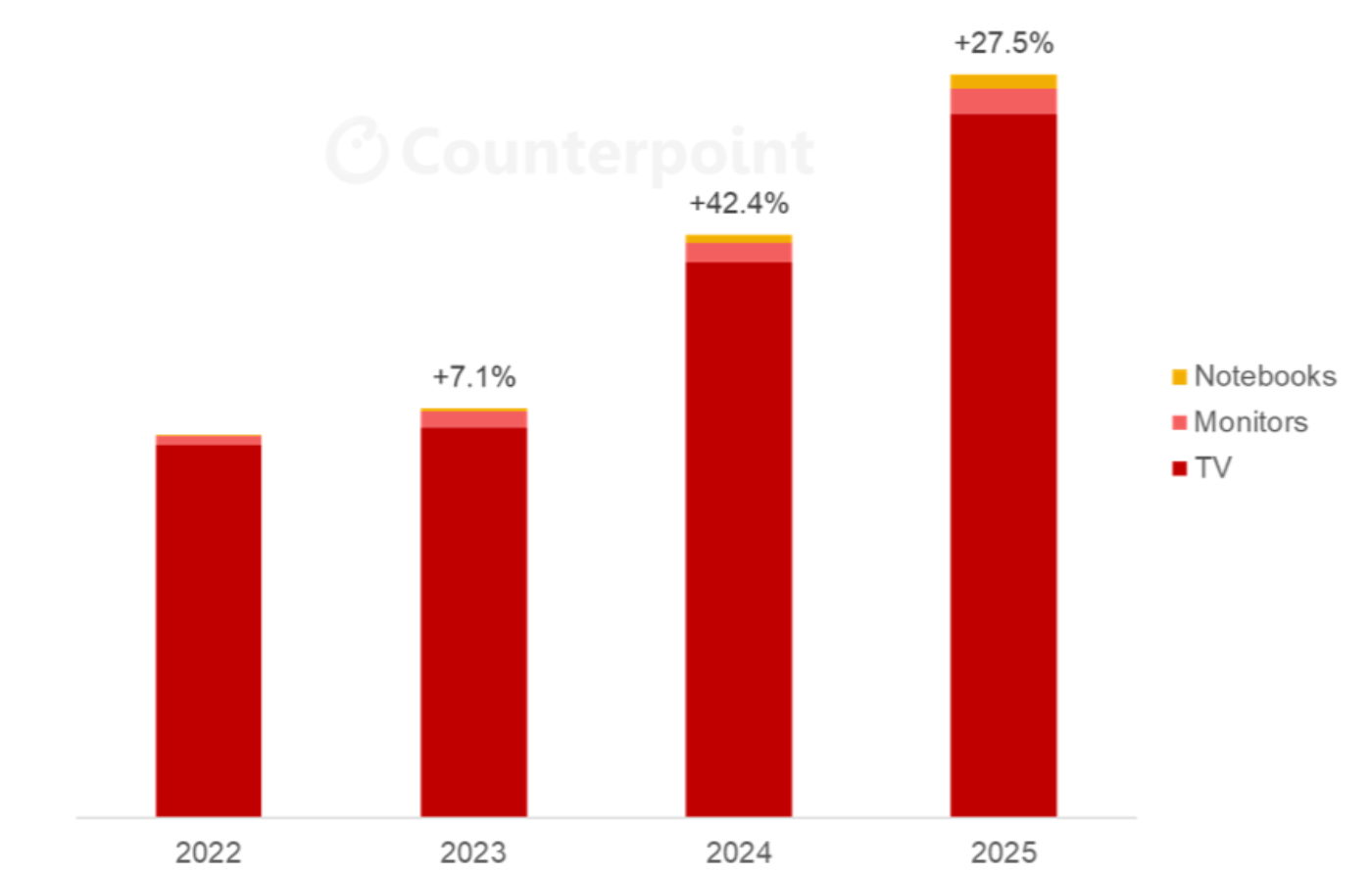量子ドット (QD) 出荷額、2024年は2桁成長~ディスプレイへの採用拡大がけん引
これらCounterpoint Research FPD部門 (旧DSCC) 発の分析記事をいち早く無料配信するメールマガジンにぜひご登録ください。ご登録者様ならではの優先特典もご用意しています。【簡単ご登録は こちらから 】
記事のポイント
- 2024年の量子ドットフィルムおよびディフューザープレート市場は前年比42%増を記録した。
- 市場の大部分を占めるQD-LCDおよびMiniLED TVが成長の原動力となった。
- 一部のTVにおける低濃度フィルム関連の議論はあるものの、2025年も2桁成長が続くと予測される。
- ノートPCとモニターはさらなる急成長が期待されるが、量子ドット市場全体に対しては小さなセグメントにとどまる見込みだ。
- ただし、新たな米国関税が恒久化すれば、プレミアムディスプレイ需要が抑制される可能性がある。
- QD-OLEDパネル材料出荷額は前年比38%増となったが、Samsung Displayで量子ドットインクの利用効率向上が見込まれることから、2025年には減少すると見られる。
Counterpoint Researchの Quantum Dot Display Technology and Market Outlook Report によると、2024年の量子ドットフィルムおよびディフューザープレート出荷額は前年比42%増を記録した。この急成長の原動力となったのはQD-LCDおよびMiniLED TVである。ノートPCセグメントは昨年も比較的小規模にとどまったが、AppleがMacBook Proに量子ドットを採用したこともあり、出荷額は228%増加している。
同レポートの主筆アナリストであるGuillaume Chansinは次のように述べている。「昨年末、新たなM4 MacBook Proが蛍光体の代わりに量子ドットを採用していることを私たちは明らかにした。Appleはそれまでディスプレイに量子ドットを採用したことがなく、この決定は、量子ドット技術が同社の性能およびコスト要件を満たしていることを示唆するものだった。これはまた、ハイエンドMiniLEDディスプレイ用の最良の色変換ソリューションとして量子ドットを確固たるものにした」
しかし、ここ数ヵ月間、業界を揺るがしている論争がある。複数のTVブランドが、「QLED」や「Quantum Dot MiniLED」と明記されたモデルにごく微量の量子ドットしか使用しておらず、消費者を欺いたとして非難されている。米国ではTCLとHisenseに対し2件の集団訴訟が起こされており、短期的には両社の製品に対する信頼が損なわれるかもしれない。また、今回の件でTVメーカー各社の透明性が高まり、QLEDの定義が標準化される可能性もある。論争にもかかわらず、量子ドットフィルムおよびディフューザープレートの需要は成長を続ける見通しで、2025年の出荷額は前年比27.5%増になると予測されている。
ただし、米国が新たに発動した関税がTV含むアジアからの輸入品に劇的な影響を与えそうだ。関税が長期にわたって維持されれば、小売業者は値上げを余儀なくされ、高級ディスプレイの需要が抑制されることになるだろう。関税のレベルと期間について、現時点では明確な見通しは立っていない。
量子ドットはSamsung Displayが製造するQD-OLEDパネルにも含まれている。生産能力増強により、QD-OLEDの量子ドット材料種化学は2024年に約38%増加した。Samsung Displayは2025年にモニターパネル出荷を50%増やす計画を発表しているが、生産能力は依然として限定的であり、TVパネル出荷は減少が予測されている。同社はまた、量子ドットの消費量削減のため、インクのリサイクル技術の導入にも着手している。その結果、2025年には材料出荷額が減少すると見られる。
[原文] Increased Quantum Dot Adoption in Displays Drives Double-digit Revenue Growth in 2024
- The market for quantum dot films and diffuser plates increased 42% YoY in 2024.
- The key driver was QD-LCD and MiniLED TVs which accounted for the bulk of the market.
- We expect double-digit growth to continue in 2025, despite controversy over low-concentration films in some TVs.
- Notebooks and monitors to grow at an even steeper rate but will remain a small segment of the QD market.
- However, the new US tariffs will curb demand for premium displays if they become permanent.
- Material revenues in QD-OLED panels increased 38% YoY but are expected to decline in 2025 as Samsung Display improves quantum dot ink utilization.
Revenues for quantum dot film and diffuser plates grew 42% YoY in 2024, according to Counterpoint Research’s Quantum Dot Display Technology and Market Outlook Report. The sharp increase was driven by QD-LCD and MiniLED TVs. While the notebook segment remained relatively small last year, revenues increased 228%, thanks in part to Apple finally adopting quantum dots in its MacBook Pro.
“At the end of last year, we revealed that the new M4 MacBook Pro used quantum dots instead of phosphors”, said Guillaume Chansin, Associate Director at Counterpoint Research. “Apple never had quantum dots in its displays before, so this decision showed that the technology had met its performance and cost requirements. This also solidified quantum dots as the best color conversion solution for high-end MiniLED displays.”
However, there is a controversy that has rocked the industry in recent months. Several TV brands have been accused of misleading consumers by using negligible amounts of quantum dots in models clearly labeled as “QLED” or “Quantum Dot MiniLED”. Two class-action lawsuits have been filed in the US against TCL and Hisense, which could undermine confidence in their products in the short term. This could also lead to more transparency from TV makers and a standardized definition for QLED. Despite the controversy, demand for quantum dot films and diffuser plates is still expected to grow, with an estimated 27.5% YoY increase in 2025 revenues.
However, the newly imposed tariffs in the US are set to make a dramatic impact on imports from Asia, including TVs. If the tariffs are maintained for a prolonged time, retailers will have to increase prices, which will curb demand for premium displays. At this time, there is still no clear visibility on the level and duration of tariffs.
Quantum dots are also found in QD-OLED panels manufactured by Samsung Display. Thanks to additional production capacity, revenues for quantum dot materials in QD-OLED increased by around 38% in 2024. Although Samsung Display has announced plans to increase shipments of monitor panels by 50% in 2025, capacity remains limited and so we expect lower shipments of TV panels. The company has also started to implement an ink recycling technology to reduce its consumption of quantum dots. As a result, material revenues are expected to decline in 2025.
